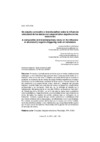Identificador persistente para citar o vincular este elemento:
https://accedacris.ulpgc.es/jspui/handle/10553/107281
| Campo DC | Valor | idioma |
|---|---|---|
| dc.contributor.author | Batista Espinosa, Luisa María | en_US |
| dc.contributor.author | Konstantinidi, Konstantina | en_US |
| dc.contributor.author | Batista Espinosa, Francisco Javier | en_US |
| dc.date.accessioned | 2021-05-24T15:35:27Z | - |
| dc.date.available | 2021-05-24T15:35:27Z | - |
| dc.date.issued | 2021 | en_US |
| dc.identifier.issn | 1579-9794 | en_US |
| dc.identifier.other | Scopus | - |
| dc.identifier.uri | https://accedacris.ulpgc.es/handle/10553/107281 | - |
| dc.description.abstract | Frequently, translators have to deal with emotionally complex translations that may have consequences on both the translator and the final text. The aim of this study is to analyse the degree of influence of those texts that trigger negative emotions, with which the translator should deal, through the observation and quantification of the emotions that they experience, before, during and after the translation process of this type of texts, by comparing professional and non-professional translators. For this purpose, the Thinking Aloud Protocols (TAP) and the EVEA have been used, in order to obtain data, both qualitative and quantitative, respectively. The results show that the psychological mood of all the subjects has changed after the translation process. Furthermore, although there are variations between the emotional levels of the two groups, the differences are not significant. It can therefore be concluded that emotional texts affect translators to a greater or lesser extent and that professionalism may not be one of the factors related to the management of emotions in this type of texts. | en_US |
| dc.description.abstract | A menudo, los traductores se tienen que enfrentar a traducciones complejas a nivel emocional que pueden tener consecuencias tanto en el traductor como en el texto final. El objetivo del presente trabajo es analizar el grado de la influencia de los textos de carga emotiva negativa en el estado psicológico de los traductores, mediante la observación y la cuantificación de las emociones que experimentan antes, durante y después del proceso traductor, cuando lidian con este tipo de textos, comparando a traductores profesionales y en formación. Para ello, se ha utilizado el método de la verbalización del pensamiento en voz alta (TAPs) y la Escala de Valoración del Estado de Ánimo (EVEA), con el fin de obtener datos tanto cualitativos como cuantitativos, respectivamente. Los resultados indican que el estado de ánimo de todos los sujetos ha sufrido cambios tras la realización de la traducción. Además, a pesar de que existan variaciones cuantitativas entre los niveles emotivos de los dos grupos, las diferencias no son significativas. Por lo tanto, se puede concluir afirmando que, en mayor o en menor medida, los textos emotivos afectan a los traductores y que la profesionalidad puede que no sea uno de los factores relacionados con la gestión de las emociones en este tipo de textos. | en_US |
| dc.language | spa | en_US |
| dc.relation.ispartof | Hikma | en_US |
| dc.source | Hikma [ISSN 1579-9794], v. 20 (1), p. 185-219, (Abril 2021) | en_US |
| dc.subject | 570113 Lingüística aplicada a la traducción e interpretación | en_US |
| dc.subject | 610603 Emoción | en_US |
| dc.subject.other | Emotional Impact | en_US |
| dc.subject.other | Psychology | en_US |
| dc.subject.other | Translator | en_US |
| dc.subject.other | Traductor | en_US |
| dc.subject.other | Impacto emocional | en_US |
| dc.subject.other | Psicología | en_US |
| dc.subject.other | TAP | en_US |
| dc.subject.other | EVEA | en_US |
| dc.title | Un estudio contrastivo e interdisciplinar sobre la influencia emocional de los textos con carga emotiva negativa en los traductores | en_US |
| dc.title.alternative | A comparative and interdisciplinary study on the influence of emotionally negative triggering texts on translators | en_US |
| dc.type | info:eu-repo/semantics/Article | en_US |
| dc.type | Article | en_US |
| dc.identifier.doi | 10.21071/HIKMA.V20I1.13007 | en_US |
| dc.identifier.scopus | 85105817783 | - |
| dc.contributor.authorscopusid | 57223391615 | - |
| dc.contributor.authorscopusid | 57223388013 | - |
| dc.contributor.authorscopusid | 57223397993 | - |
| dc.identifier.eissn | 2445-4559 | - |
| dc.description.lastpage | 219 | en_US |
| dc.identifier.issue | 1 | - |
| dc.description.firstpage | 185 | en_US |
| dc.relation.volume | 20 | en_US |
| dc.investigacion | Artes y Humanidades | en_US |
| dc.type2 | Artículo | en_US |
| dc.utils.revision | Sí | en_US |
| dc.date.coverdate | Abril 2021 | en_US |
| dc.identifier.ulpgc | Sí | en_US |
| dc.contributor.buulpgc | BU-HUM | en_US |
| dc.description.sjr | 0,221 | |
| dc.description.sjrq | Q1 | |
| dc.description.dialnetimpact | 0,0 | |
| dc.description.dialnetq | Q2 | |
| dc.description.dialnetd | D4 | |
| dc.description.miaricds | 7,8 | |
| dc.description.erihplus | ERIH PLUS | |
| item.fulltext | Con texto completo | - |
| item.grantfulltext | open | - |
| crisitem.author.dept | GIR IATEXT: Cognición, Lingüística, Texto y Procesamiento de la Información | - |
| crisitem.author.dept | IU de Análisis y Aplicaciones Textuales | - |
| crisitem.author.orcid | 0000-0001-7683-1335 | - |
| crisitem.author.parentorg | IU de Análisis y Aplicaciones Textuales | - |
| crisitem.author.fullName | Konstantinidi,Konstantina | - |
| Colección: | Artículos | |
Citas SCOPUSTM
3
actualizado el 08-jun-2025
Visitas
255
actualizado el 14-dic-2024
Descargas
220
actualizado el 14-dic-2024
Google ScholarTM
Verifica
Altmetric
Comparte
Exporta metadatos
Los elementos en ULPGC accedaCRIS están protegidos por derechos de autor con todos los derechos reservados, a menos que se indique lo contrario.
